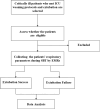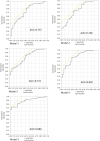Novel mechanical ventilator weaning predictive model
- PMID: 32729992
- PMCID: PMC11896436
- DOI: 10.1002/kjm2.12269
Novel mechanical ventilator weaning predictive model
Erratum in
-
Corrigendum to "Novel mechanical ventilator weaning predictive model"[Kaohsiung J Med Sci. 2020;36(10):841-849].Kaohsiung J Med Sci. 2020 Nov;36(11):957. doi: 10.1002/kjm2.12321. Kaohsiung J Med Sci. 2020. PMID: 33171545 Free PMC article. No abstract available.
Abstract
Mechanical ventilation (MV) is a common life support system in intensive care units. Accurate identification of patients who are capable of being extubated can shorten the MV duration and potentially reduce MV-related complications. Therefore, prediction of patients who can successfully be weaned from the mechanical ventilator is an important issue. The electronic medical record system (EMRs) has been applied and developed in respiratory therapy in recent years. It can increase the quality of critical care. However, there is no perfect index available that can be used to determine successful MV weaning. Our purpose was to establish a novel model that can predict successful weaning from MV. Patients' information was collected from the Kaohsiung Medical University Hospital respiratory therapy EMRs. In this retrospective study, we collected basic information, classic weaning index, and respiratory parameters during spontaneous breathing trials of patients eligible for extubation. According to the results of extubation, patients were divided into successful extubation and extubation failure groups. This retrospective cohort study included 169 patients. Statistical analysis revealed successful extubation predictors, including sex; height; oxygen saturation; Glasgow Coma Scale; Acute Physiology and Chronic Health Evaluation II score; pulmonary disease history; and the first, 30th, 60th, and 90th minute respiratory parameters. We built a predictive model based on these predictors. The area under the curve of this model was 0.889. We established a model for predicting the successful extubation. This model was novel to combine with serial weaning parameters and thus can help intensivists to make extubation decisions easily.
Keywords: critical care; mechanical ventilation; weaning.
© 2020 The Authors. The Kaohsiung Journal of Medical Sciences published by John Wiley & Sons Australia on behalf of Kaohsiung Medical University.
Conflict of interest statement
The authors declare no potential conflict of interest.
Figures
References
-
- Tobin M, Manthous C. Mechanical ventilation. Am J Respir Crit Care Med. 2017;196(2):P3–P4. - PubMed
-
- Tobin MJ. Advances in mechanical ventilation. N Engl J Med. 2001;344(26):1986–1996. - PubMed
-
- Thille AW, Richard JC, Brochard L. The decision to extubate in the intensive care unit. Am J Respir Crit Care Med. 2013;187(12):1294–1302. - PubMed
-
- Pellegrini JA, Moraes RB, Maccari JG, de Oliveira RP, Savi A, Ribeiro RA. Spontaneous breathing trials with T‐piece or pressure support ventilation. Respir Care. 2016;61(12):1693–1703. - PubMed
MeSH terms
Grants and funding
LinkOut - more resources
Full Text Sources



